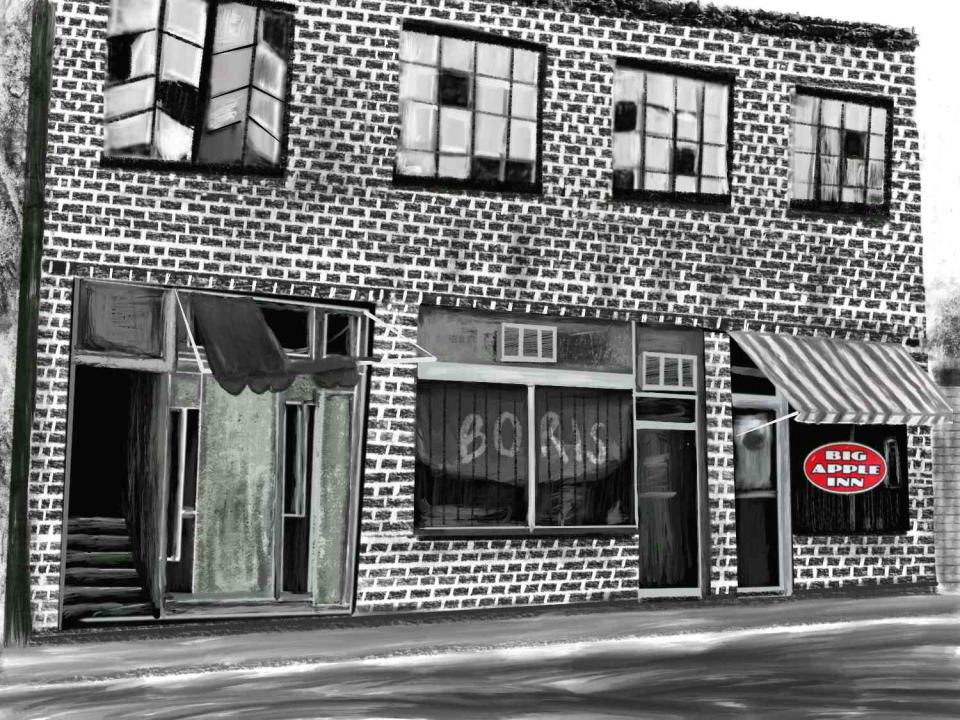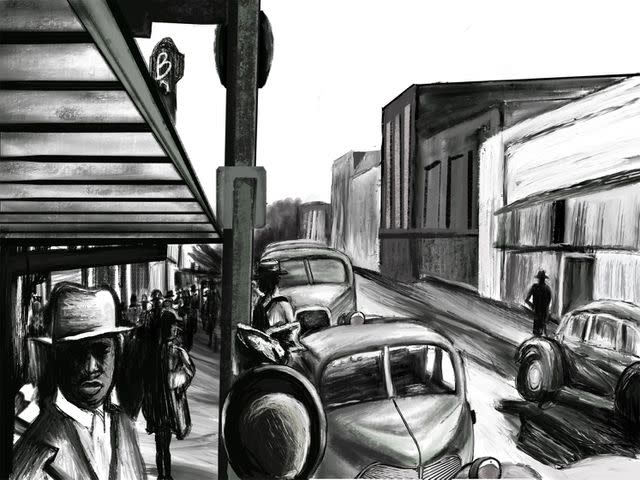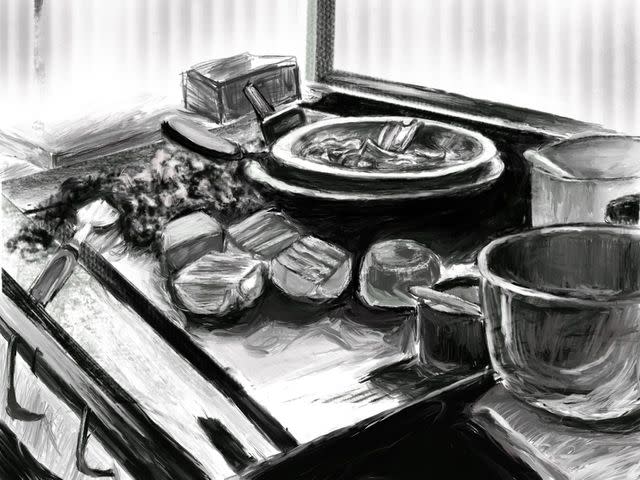The Big Apple Inn, A Little Mississippi Diner With an Outsize History
- Oops!Something went wrong.Please try again later.
Its walls have witnessed more history than the average hole-in-the-wall diner.

Serious Eats / Johnalynn Holland
On Farish Street in Jackson, Mississippi, amid boarded-up storefronts that were once grocery stores, restaurants, and bookshops, just one building shows signs of life. Flanked by a long-closed beauty shop and a cross street, its crimson-and-white awnings flutter above windows protected by metal grills. A fluorescent “OPEN” sign flickers behind the glass, alongside rows of mustard and ketchup tubs.
Inside, a pegboard menu advertising burgers and hot dogs hangs behind the long counter stretching perpendicular to the entrance. A strip light dangles from the ceiling next to a bulb with a Stetson-shaped shade, and yellowing newspaper clippings, music posters, and local notices decorate the walls around a jukebox. At the back is a row of Formica tables with a dozen seats. The entire room is scented with comforting aromas of pork fat, warm bread, and sweet chili sauce.
A Humble Restaurant With an Illustrious Past
At first glance, there’s nothing especially remarkable about the Big Apple Inn. But its walls have witnessed more history than the average hole-in-the-wall diner. This is one of the few remaining businesses on Farish Street, once a thriving African-American neighborhood on the edges of downtown Jackson. Back in the day, some called it “black Mecca”; others nicknamed it “Little Harlem.” But in the years following desegregation, the city’s black residents, formerly confined to a limited set of neighborhoods, began shopping and eating in other parts of the city—places where they had previously been unsafe or felt uncomfortable, or had been outright prohibited from visiting.
“We started going to white places and stopped going to our own,” Geno Lee, fourth-generation owner of the Big Apple Inn, tells me. “People moved out, and these areas took a slow decline. Desegregation was great for the black race, but it killed the black businessman.” Farish Street declined in step with the other African-American neighborhoods of Jackson.
Yet, in the 1950s and ‘60s, this tiny restaurant played a key role in the civil rights movement. Leaders and activists crowded within these wood-paneled walls to discuss strategy and plan actions, including the 1961 Freedom Rides, in which buses of black and white college students traveled across the South to protest against segregation. While the barber shops, clothing stores, and furniture warehouses that lined this street have since closed—and the only other eatery on Farish is Johnny T’s Bistro & Blues, which opened in 2015—the Big Apple Inn remains, an understated but potent reminder of the street’s rich heritage. And though the restaurant loses money, Geno Lee is determined not to shut its doors: It has too many stories worth sharing. “It’s the history that keeps me here,” says Lee, who has two other, more lucrative Big Apple Inn outposts in Jackson. “This is history that needs to be remembered and preserved.”

Serious Eats / Johnalynn Holland
For Lee, that history is personal, and familial. As documented by the Southern Foodways Alliance, Lee’s great-grandfather Juan “Big John” Mora arrived in the area from Mexico in the 1930s, launching his business with a tamale cart before opening his first brick-and-mortar in 1939—just across the street from the current location, which opened in 1952. He named the restaurant after his favorite swing dance, the Big Apple, and added hot dogs, bologna sandwiches, hamburgers, and “smokes”—buns filled with ground smoked hot sausage—to the menu. Mora had a son, Harold Lee, with a local African-American woman known only as Mae-Mama. Where exactly the Lee name came from is a mystery neither Mora nor his son revealed before their deaths, in 1973 and 2008, respectively.
The Big Apple's Unique Specialty
One thing Geno Lee does know is the origin of the restaurant’s unusual but beloved pig-ear sandwiches. Soon after opening the restaurant, Mora was offered a box of floppy, rubbery pig ears, destined for the trash heap, by his regular butcher. After experimenting with deep-frying, baking, and simmering, he came up with a method to make them tender as thick slices of ham: boiling for two days. Their oval shape made them perfect for sandwiches.
“Poor people in the country would eat pig ears chopped up and mixed with greens, because they were too tough to eat whole,” Lee tells me. “Great-Grandfather was the first person to put a pig ear in a sandwich, as far as we know.”
The menu hasn’t changed since then, and the Big Apple Inn is still one of the few places in Jackson to serve hot tamales, a nod to the family’s Mexican heritage. But the pig ears—now tenderized via the more streamlined method of pressure-cooking for two hours—are the most popular menu item. Each ear is slapped into a slider bun; slathered with mustard, slaw, and homemade chili sauce; and priced at $1.10 apiece. Some customers double up with two ears; others order a combination of pig-ear sandwich and smokes. The ears are soft, with a slight bite—like firm jelly, with a gossamer-thin wafer of cartilage inside. The texture takes some getting used to, but the flavor is sweet, rich, and moreish.
Joe York, who filmed a documentary on the Big Apple Inn for the Southern Foodways Alliance, describes the pig ears as “like oysters—only better.” In other words, he tells me, they’re an acquired taste. “The sandwiches are unlike anything you will ever eat. Like [blues musician and longtime Big Apple Inn customer] Bobby Rush says in my video, they’re delicious. The right mix of pork flavor and slaw and hot sauce. And they’re delicious because the family has been making them for 79 years.”

Serious Eats / Johnalynn Holland
A Meeting Place for the Civil Rights Movement
Despite their uniqueness, the pig-ear sandwiches alone aren’t what makes the Big Apple Inn significant. During a period when segregation laws restricted where nonwhite people could dine—or do anything, for that matter—Farish Street was a hub where black-owned businesses thrived, and a safe place for people to gather and socialize. “People would pile on trucks, get dropped off, and spend the day here, because there was nowhere else to go,” says Lee. And that feeling of security for the city’s African-American residents is what led the Big Apple Inn to take on its eventual role as a gathering spot when the civil rights movement began to take shape.
Above the restaurant is a window, slightly ajar, with panes of glass missing and a rotting wooden frame. This upstairs space was used as a boarding house—tenants included blues legend Sonny Boy Williamson II—and, later, offices. Civil rights leader Medgar Evers rented an office here soon after becoming Mississippi field secretary for the NAACP in 1954. Minnie Watson, curator of the Medgar Evers Home, where Evers was assassinated by white supremacist Byron de la Beckwith in 1963, says that he regularly held meetings “above this hole-in-the-wall restaurant in downtown Jackson” until his death. Those meetings regularly spilled out from Evers’s tiny office into the restaurant itself. Lee’s father, Gene, remembers civil rights leader Fannie Lou Hamer also renting an office, though Lee hasn’t been able to find documentation to back this up. “She definitely visited the restaurant a few times, and likely would have attended the meetings,” adds Lee.
Activists involved in the Freedom Rides would stop by to update Evers and get further instructions. “Dad remembers a lot of people always being here in the restaurant when they were holding meetings,” says Lee. “Medgar’s brother, Charles Evers, said the reason they chose that space was because it was the only place that was affordable, and only black people gathered in this area. So it was safe.” Lee’s mother, Mary, who died in 2016, was also a Freedom Rider, though her involvement ended after she was arrested and threatened with the death penalty.
Lee’s grandfather was also “very involved in the civil rights movement.” He rarely spoke about it, Lee tells me, but regular customers from the time recount stories of Harold Lee giving out free food and helping to bail people out when they were arrested for civil rights activities. “Back then it was just an issue of survival, rather than an important period in history,” says Lee.
When meetings were held in the restaurant, often with more than 50 people crowding into the tiny room, it’s “more than likely [attendees would eat] pig-ear sandwiches,” according to Lee. York adds: “They would go into the Big Apple Inn for lunch and, while eating their pig-ear sandwiches and smokes, talk about how to do this sit-in, how to organize this march.”
An Uncertain Future
Today, customers swing by for a pig-ear sandwich and a slice of nostalgia. Evers’s widow, Myrlie Evers-Williams, now based in California, “comes down sometimes to reminisce,” according to Lee. James Meredith, who became the first black student to enroll at Ole Miss in 1962 and now lives in Jackson, has also popped in for lunch. “We have one guy who comes quite often and always lets us know that he’s probably one of our oldest customers,” Lee says. “He knew my great-grandfather very well. He talks about how Farish Street was its own indigenous community and took care of itself.” Regulars and locals are often joined by tourists who have read about or viewed York’s documentary on the Big Apple Inn. They come to the Farish Street location over the others, says Lee, “for the history and the whole experience.”
The future of the restaurant is uncertain. Lee wanted to buy the upstairs rooms and turn them into a museum; he even secured financial backing from the city to do so. But the owners of that space—heirs of the original purchaser, S. D. Redmond—refuse to sell. There’s been talk of regenerating the area as an entertainment district, like Memphis’s Beale Street, so Lee believes the owners are waiting for prices to rise. Currently, however, no concrete plans for such revitalization are in place. Though it has been on the National Register of Historic Places since 1980, Farish Street remains an eerily quiet stretch of rundown buildings, most of them empty.
“The Big Apple is still very vital, even if the rest of the street is having issues,” says York. “It’s also a place that has always been affordable. They could charge more but don’t, because part of the legacy is providing really good food at a really good price that people can afford. It’s a space where people feel welcome, in a country where not everyone feels welcome right now.”
June 2018
Read the original article on Serious Eats.

